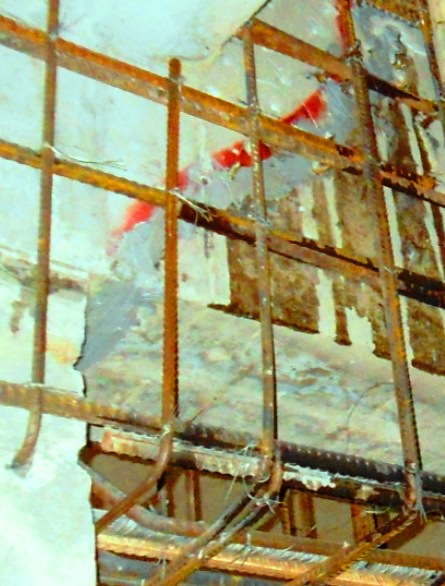How to Repair Reinforcement of Reinforced Concrete?
Tow type of steels are used in concrete as reinforcement, if deteriorated both are repaired to continue present structural service or to strengthen existing structures-two types are reinforcing steel & prestressing steel. Two types perform in concrete in different mechanisms and seek different procedures of repair.
Again exposure condition of steel helps to determine alternative procedures of repair. We will discuss here about repair of reinforcing steel. The removal methods of concrete and preparation of surface of reinforcing steel have already been discusses in previous posts.
 |
| Supplemental reinforcement for both flexure & shear deficiency in reinforced concrete repair (by lap splicing) |
The repair alternatives of reinforcing steel are
a. Replacing deteriorated bars
b. Addition of supplemental bar for partially deteriorated
For one member both replacement and supplemental addition may be required for different location of patch areas. The selection of alternatives is matter of engineering judgment and should be based on function of reinforcement and expected structural capacity to be developed in reinforced members.
a. Replacement:
Replacement requires connection between existing reinforcement and new reinforcement. Depending on splicing method, replacement can divided into three methods
• Lap splicing
• Welded splicing
• Application of mechanical connections
Lap splicing:
In this method reinforced is cut out from damaged portion for replacement and with proper laps spliced with new reinforcing bars. In lap splicing, length of splice is very important and must be conformed all requirements of ACI code (ACI-318). We know there have different categories of splicing depending on performance of steel in particular portion of structural member.
Welded splicing
In case of welded splicing, the code and standard should be follow are
• ACI-318
• AWS D1.4 (American welding society).
High quality welding is required in butt welding as full penetration up to bask side of rebars are very difficult (as inaccessible); and generally not recommended.
Again when welding of larger diameter bar [>25mm (NO.8)] is required, problem arises with heat of welding which is sometimes enough to produce cracks in surrounding concrete.
Mechanical splicing
Another method splicing bar is mechanical connections. Generally proprietary devices are used in this type of splicing and ACI 439.3R provides us description of different commercial products available in market. Such connections must fulfill code requirements (ACI318).
b. Supplemental Reinforcing:
When deterioration results lost in cross section and without replacing reinforcement adding some additional reinforcing bars, the member can be repaired or existing member can be strengthened, this alternative is chosen. Thus inadequacy may arise form deterioration or for strengthening of existing structure.
Engineer will decide whether supplemental reinforcing is required or not. The deteriorated reinforcement have to be cleaned thoroughly, we have discussed this procedure in last post.
Concrete is chipped off to facilitate placement of addition bar as supplement beside older reinforcement.
Bar length required = (Deteriorated length of bar of respective segment)
+ (Length of lap splice required for each end).
+ (Length of lap splice required for each end).
The length of splicing should comply with ACI 318. If mixed bar size is used length of splice should be based on smaller bar size.
New or existing bars are not embedded by placed concrete immediately after cleaning, which may rust again and further cleaning is required. In this situation, coating may be applied which not only prevent rusting but also provide corrosion protective coating.
As coating we can use
• Zinc coating
• Slurry of latex-cement
• Epoxy
Each of them performs very well against corrosion due to chloride contamination. The coating thickness is limited to 0.3mm (12 mils) to have proper bond strength to avoid slip during deformation.
Deformed bars that have lost surface deformations due to corrosion will lose bond with repair materials; cleaning of rebar also results lose in deformation and if these bars are coated further the bond strength will further reduced. Less bond strength will seek more splice length as usual.